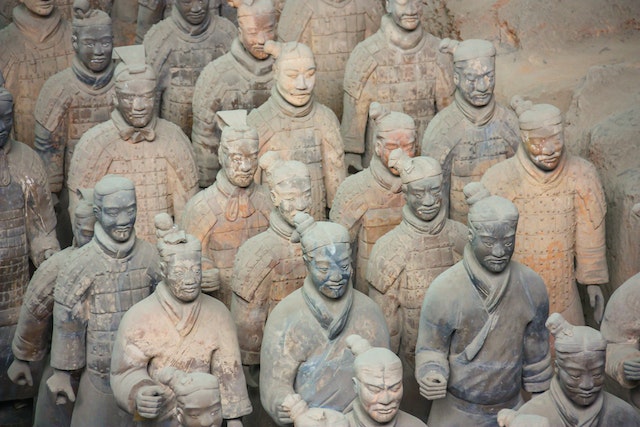
Why were the Terracotta Warriors buried? They were buried to protect Qin Shi Huang, the first emperor of China, in the afterlife.
Qin Shi Huang was a very influential ruler of China. He was the first emperor of a unified China and a lot of things were begun in his reign. He combined many walls that already existed into the Great Wall of China, started a road building campaign, and many significant inventions came about in his reign. He managed to take over several other clans, making the first country of China and he called himself emperor. His China was nowhere near as big as modern China, but he is a very important figure in Chinese history.
The Terracotta Warriors are an army of soldiers, generals, horses, carts, chariots, and all of the other things that go together to make up an army. So far, about 2,000 warriors, horses, and chariots have been excavated, but ground scanning has shown that there could be another 6,000 warriors, 130 chariots, and 670 horses still buried. They are being left for now because when they are dug up, the paint on them peels off in minutes, leaving them as the grey color we know. Tests on the paints show that they were originally painted in bright colors. There was no mold for the statues because each one of them is different, showing they were handmade.
The Terracotta Warriors are in formation. There are infantry, archers, people leading horses, officials, and generals. The statues vary in height, with the more important people being taller. All of the statues are pointed towards the east and they are about 1.5 km away from the mausoleum of Emperor Qin. His mausoleum hasn’t been excavated, but probes dug into the ground show that there are even more statues around his mausoleum. They are dancers, musicians, acrobats, and many other characters, along with animals as well. The emperor is buried in the middle, and the whole area is perhaps meant to represent his palace. Emperor Qin’s mausoleum hasn’t been excavated, but it appears that he was buried in a giant underground palace with passageways and rooms. There might be more figures inside that palace, too. The Terracotta Warriors and the palace would have been a mammoth task. It is estimated that it took 700,000 workers about 7 years to build all of the statues.
The first Terracotta Warriors were discovered in 1974 by workers who were digging a well outside the city of Xi’an in China. Xi’an is pronounced shee-AN and it is about 1,000 km southwest of the capital, Beijing. Xi’an might seem a strange location to have such an incredible archaeological discovery, but Beijing has only been the capital of China since 1949. Before that, many cities had capital status because many dynasties ruled different parts and different amounts of China. In the time of Qin Shi Huang, 259 to 210 BC, the capital of the Qin dynasty was in Xi’an.
So, why were the Terracotta Warriors buried? There are possibly four reasons. The first reason is that they were built as an army to protect Qin Shi Huang in his afterlife. A powerful emperor would need a powerful army to protect him once he had died. It was the tradition in many countries for kings to be buried with treasures and possessions for them to use in the afterlife. Early China was no different. A second reason was that they were built in place of human sacrifices. A lot of early kings were buried with actual people. Their family and slaves were often sacrificed and buried with them. Perhaps Emperor Qin saw the impracticality of sacrificing 8,000 soldiers and opted to go with statues instead.
A third reason is that Emperor Qin believed in his own importance and wanted his mausoleum to show that importance. Like the pharaohs in Egypt, he wanted a mausoleum that wowed people. He was a rich and powerful leader and he wanted his mausoleum to reflect that. Emperor Qin is said to have started building the mausoleum when he ascended to the throne at the age of 13, but evidence shows that he probably began after he had conquered the other states and unified China. Before then, it would be unlikely that he would have had the power or the money to make it happen.
And the fourth reason is as a warning. All of the Terracotta Warriors are facing east. Emperor Qin had united all of the states to the west, and his next targets were the states to the east. The position of the warriors could be telling his enemies that they would be next. That never happened because the Qin dynasty ended with Qin’s son. And this is what I learned today.
Photo by Maciej Cisowski: https://www.pexels.com/photo/terracotta-army-statues-11105685/
Sources
https://www.smithsonianmag.com/smart-news/200-more-terracotta-warriors-excavated-china-180973900/
https://en.wikipedia.org/wiki/Terracotta_Army
https://en.wikipedia.org/wiki/Qin_Shi_Huang
https://en.wikipedia.org/wiki/Mausoleum_of_the_First_Qin_Emperor
https://www.nationalgeographic.com/history/article/emperor-qin
https://www.discovermagazine.com/the-sciences/an-underground-army-the-8-000-terracotta-warriors
https://www.chinahighlights.com/xian/terracotta-army/who-and-why-built.htm
https://www.history.com/topics/ancient-china/qin-dynasty
https://www.chinahighlights.com/xian/terracotta-army/
https://en.wikipedia.org/wiki/Mausoleum_of_the_First_Qin_Emperor
